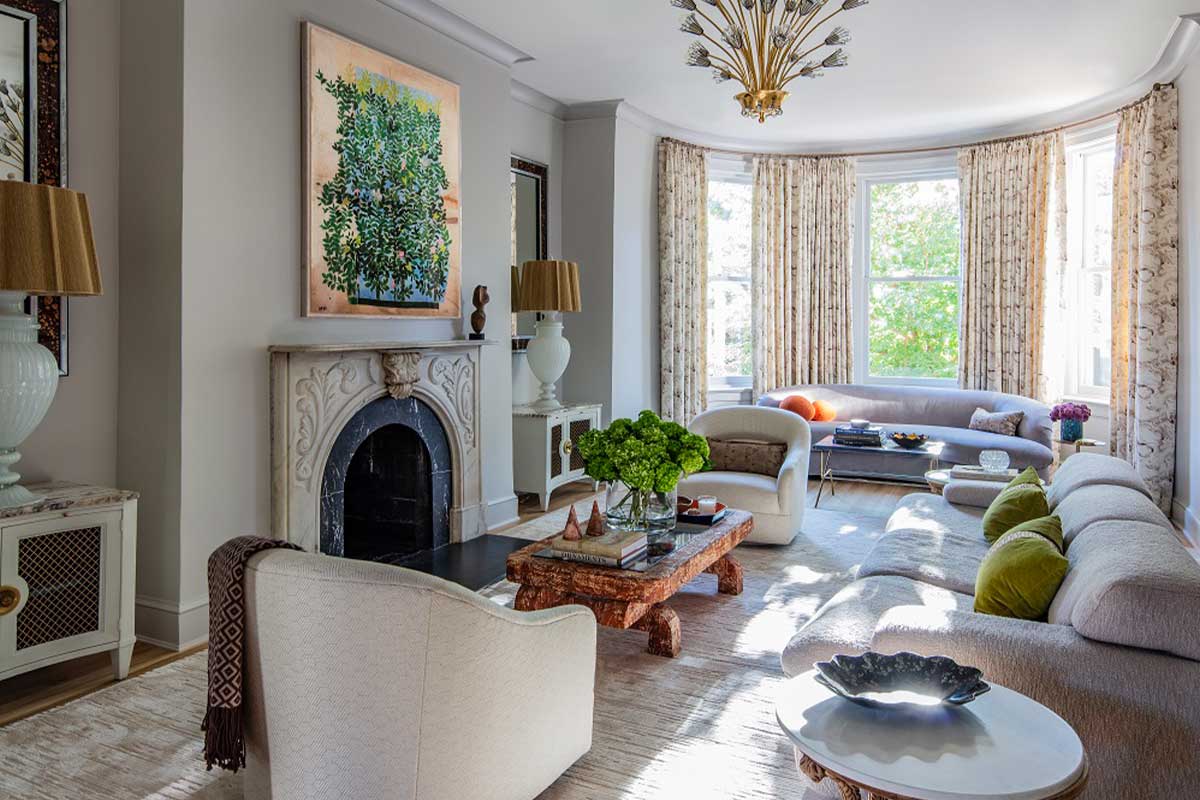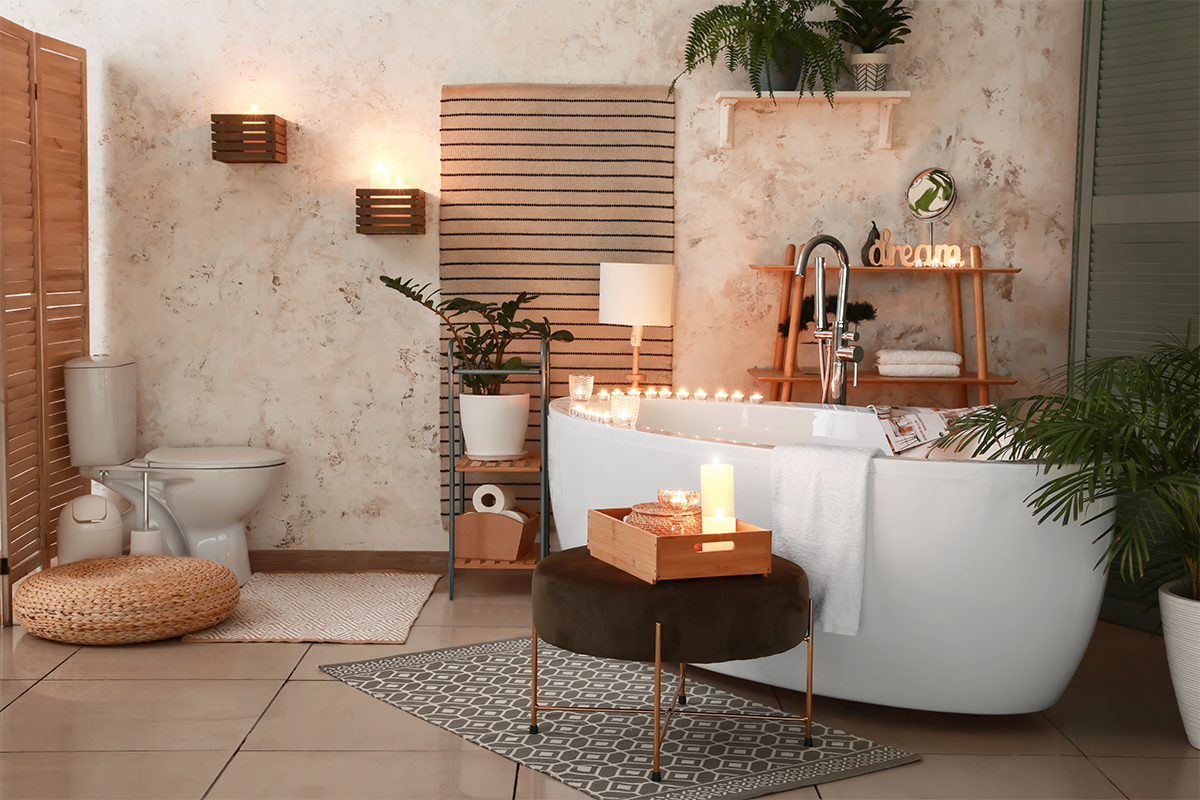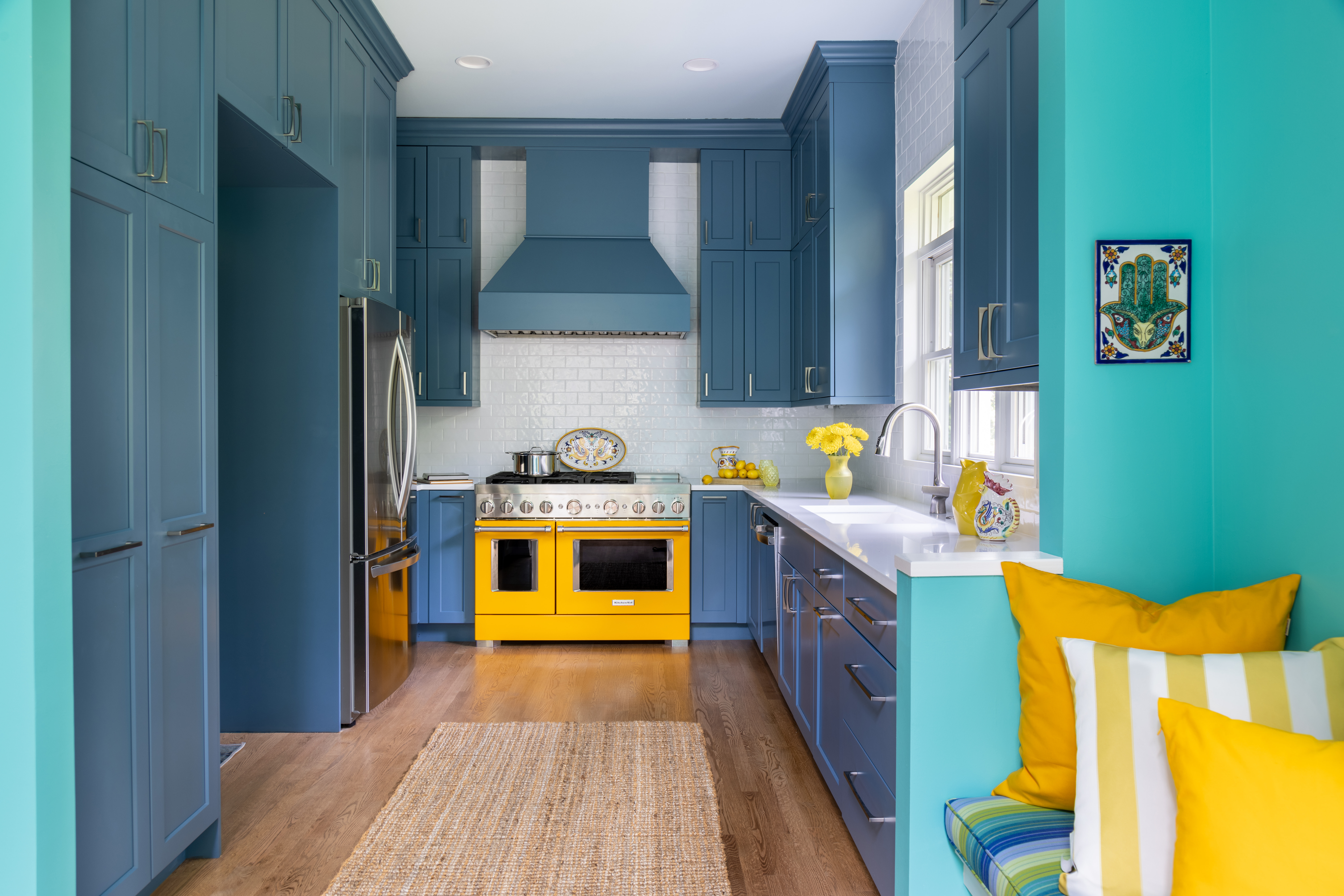Convert your space into a place for everything
By Jennifer Shapira
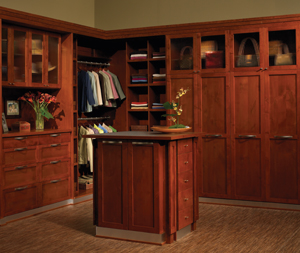
A crystal chandelier hangs above a marble-topped island. Soothing sounds of an iPod playlist pipe in overhead. A scented candle adds to a relaxed setting. Thirty pairs of shoes, from heels to boots to sandals, rest at ease in built-in cubbyholes. Handbags from around the world are displayed floor to ceiling, always at the ready. Two dozen other, more precious, purses are exhibited behind clear glass doors, and each panel of a nearby three-way mirror is turned just so.
A decorative hand-painted chair sits atop a richly hued oriental carpet. Well-organized racks hold one type of clothing each: jeans, tops, suits, dresses and so on. Lively showpieces—a Tunisian wedding frock and an Afghan tunic—sparkle as they hang from well-positioned valet rods.
No, this isn’t a high-end shop. It’s the Northern Virginia closet belonging to McLean resident Edwina Rogers. And although this custom-built dressing area resides in a home where space is plentiful, local experts say many homeowners are turning spare bedrooms or guest bedrooms into dressing rooms or closets. Whether the kids have gone off to college, or there’s just a need for more storage space, creating clothing retreats is big business.
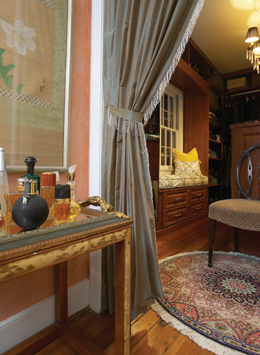
Boudoir Beauty
“I’m finding that, especially in the city and Old Town in particular, it’s just easier to convert a guest room into a walk-in closet and make it almost like a dressing room,” Alexandria-based interior designer Yvette Piaggio said. “We’re adding chandeliers and window-seat boxes, and just making it a little bit more romantic.”
Piaggio knew just what it took to transform an Old Town townhouse’s spare bedroom into an elegant boudoir. The homeowner wanted more storage space for her clothes and to be able to see everything, at all times, doing away with the seasonal storage concept. Now, everything hangs in full view, and nothing is hidden or forgotten. But it doesn’t feel like a closet per se, said Piaggio, who worked to conceive a space that was both fiercely functional and perfectly pretty.
“I just think it’s how we live today, with the seasons being so iffy,” Piaggio said. “People don’t really like to change out their wardrobes anymore. They want to have easy access. So if it’s cold one day, they want to have their sweaters available; if it’s warm they want to have a pair of shorts.”
Piaggio incorporated ultra-feminine touches: a shimmery beaded tie-back curtain serves as the walk-in’s entrance instead of a door. “It’s really very sophisticated and elegant, and it kind of teases you,” she said. “You want to look into the room. But it gives you privacy because you can draw the curtain.”
The color scheme incorporates warm woods throughout. There’s a multifunctional window-seat box that houses additional storage beneath the whimsical print. Prop up the throw pillows, and it’s a spot to unwind or slip into a pair of heels, and the window brings in natural light. A chandelier hangs above, and an antique chair sits atop a handmade rug.
The space is completely personal, said Piaggio, adding, “It’s very pretty and very soft.” Although at times closets are shared, Piaggio and others said such requests come primarily from women.
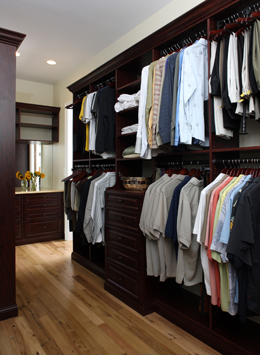
What Women (and Men) Want
“A lot of times that extra-bedroom conversion is more for the women’s clothing than anything else,” said Denny Stotlemyer, owner of a Closet Factory franchise in Waldorf, Md. “Maybe just give the guy the small closet in the [master] bedroom because, you know, that’s really all he deserves—that’s all he needs,” he joked.
Converting extra space into a closet can increase a home’s value. If and when it comes time to sell, even if you’ve converted a room, the home can still be advertised with the original number of bedrooms, Stotlemyer said.
From extensive wood shelving to high-end, no-slam drawers and hidden laundry bins, he said, “We design it so that even when you sell the house, the closet can go with you, and the space turns back into a bedroom. We do that kind of thing really frequently.”
Everyone wants more storage space, Stotlemyer said. Besides, he teased, what woman doesn’t like shoes?
Or man, for that matter. Gary Nash, a self-described fashion plate and Delaplane-based high-end homebuilder, gets dressed in a 136-square-foot closet off his master suite. And while a night out for Nash may mean he’s decked out in a DaVinci sports jacket, Diesel jeans and Hugo Boss boots, his closet, and its wall-to-wall shelving, is just right for his 30-some pairs of shoes. “I’m like a woman,” he joked.
It’s Easy Being Green
Nash’s home, the first EarthCraft-certified green home in Fauquier County, was constructed as a testament to sustainability. After taking a course in green remodeling, Nash was sold on the idea. He and the architect revamped the plans. But Nash didn’t stop there. He brought in the course instructor and promptly certified his project superintendents, sales staff, designers and project managers in green remodeling. The Delaplane home serves not only as his primary residence; it’s also a show house, Nash’s own working example of green building.
The 7,800-square-foot home with reclaimed hardwood floors costs $250 a month to operate. The home has so many windows that during the day there is no need to turn on the lights.
In the closet, Nash put in recessed LED lighting, dimmable up to 60 percent. And, in keeping with the rest of the house, a large window allows for a lot of natural light.
So it made sense that Nash would team up with ECONIZE. The Clifton-based eco-friendly closet company operated out of Windy Hill Farm is the first of its kind on the East Coast, said owner Noel Sweeney, an engineer by trade.
After opening a couple pubs in Northern Virginia, Sweeney wanted to get back to construction, but he also wanted to find a niche. After researching the closet industry, Sweeney founded Econize, a 99-percent green company. Econize constructs closets from composite panels made from recycled wood. Operating out of the farm instead of a showroom cuts down on overhead costs. Further, the company uses energy-efficient light bulbs, conducts nearly all business via email and exhibits design plans on the computer, not paper.
What people don’t realize, Sweeney said, is it’s not more expensive for a closet to go green. “People look at us and think, ‘Man, I’d like one of those someday.’ But it’s not for the rich and famous. It’s for the average homeowner.”
Sweeney, always on the lookout for the next big green thing, even uses recycled hardware for the knobs on drawers. But green initiatives are not uncommon in closet companies. “We’re certified as a licensed downstream facility,” Stotlemyer said. “The materials that we use all meet the requirements for being green. They’re manufactured within 500 miles so they don’t have to travel very far by truck. We actually optimize all of our cuttings so that we get the most out, with the least amount of waste that would end up having to go to a landfill.”
Lighting the Way
As people try to upgrade their private spaces, Chantilly Dominion Electric Supply Co. showroom buyer Erin Schwartz said, chandeliers are becoming increasingly popular, for men and women. Seen as a form of jewelry for the closet, these twinklers provide a touch of elegance. A man might consider something more masculine, like a heavy iron piece, she recommended. Another popular method of lighting? Consider illuminating favorite pieces or collections with tiny LED lights.
And there’s a definite shift toward more decorative elements, no matter your style. “People are putting crystals in where they might not have before,” said Schwartz, adding, “Lots of moms are putting crystals in little girls’ closets. They’re starting them early on that.”
People want these places to feel special, Schwartz continued. As touches like quilted ottomans and accent chairs find their way into storage spaces, closets are becoming true sanctuaries.
Convenience first. Function and style a close second.
Dominate Your Disorder
Professional organizers assist in reclaiming life’s spaces
By Jennifer Shapira
Janet Schiesl has been organized as long as she can remember. Even as a child she found peace in order.
“I remember being very young and being stressed when I couldn’t find my things,” she said. “So being organized was a way of relieving that stress for me. My homework was in the same folder. I could turn it in on time. My desk at school was always perfectly organized.”
Being able to put her finger on things, she said, “is what made me feel most comfortable.”
Now, the Centreville-based professional organizer helps others put things in their places. She devises ways to help homeowners manage their time and conquer their clutter.
Who Needs a Professional Organizer?
People need help for a variety of reasons, said Schiesl, owner of Basic Organization. For example, new mothers who suddenly come up short on time or business owners who work out of their homes can sometimes let life’s daily tasks slip. While the average person is organized enough to get through the day successfully, Schiesl says some need a little more help.
Whether it’s paying bills on time or remembering where you put your keys, personal organizers can devise systems that will make you feel more together and allow you to spend more time doing what you love, like relaxing with family, instead of wasting minutes looking for your glasses.
Michelle Bogert, president of the Washington, D.C. chapter of National Association of Professional Organizers (NAPO), has helped many clients put their finances in order. From the disorganized small business owner to the recent widow, people have put their trust in Bogert, a CPA and owner of SatisFunctional Spaces, to help them pay bills online, create and remember passwords and decode health insurance statements.
Addtionally, Schiesl and Bogert are both certified by the St. Louis-based National Study Group on Chronic Disorganization, which teaches organizers to deal with the most difficult clients: hoarders.
Getting Started
Public enemy No. 1: Clutter. Almost everyone has it. So how to conquer it? Schiesl’s general rule when it comes to paper is, if it’s something you can easily obtain a record of, toss it. Credit-card statements, gas bills—someone else will have a copy. Figure out what you need to keep, file it, and take the rest to a community shred.
But most people who call an organizer are experiencing a major or minor life change, “something you’re coping with that’s got you a little off track,” Schiesl said. “It may be moving or having a baby, or getting a new job and commuting longer than you used to. And it may be an illness in the family, or a loss of a job, or loss of a relative … And then you find that things get kind of pushed to the wayside, and suddenly you’re overwhelmed.”
No matter the concern, trained, trustworthy professionals can set you straight. Maybe you don’t have time to cook. Ease the burden by ordering groceries online and having them delivered to your home. If you can afford it, hire a personal chef. Find a service that delivers healthy meals to your home. Or plan a girls’ night out; sign up to prep a week’s worth of dinners at a nearby professional kitchen.
Wading Through Clutter
“So many people say, ‘Oh! I bet this is the worst house you’ve ever seen!’” Schiesl said. “People are so hard on themselves, because it’s never the worst house I’ve ever seen!”
The house may function just fine, she said. There just might be an issue with clutter collecting in the garage. “That’s no big deal.”
She works with many “project clients,” people who have a specific job they need done but don’t have time to undertake themselves. An organizer will map out a strategy and get started. Those who need ongoing support are known as “maintenance clients.”
“Maybe their issue is their home office, and you go in once a month and go through the paperwork,” Schiesl said.
And that garage? “We’ll just go like gangbusters, and we can haul everything out and clean it up.” Same with closets. “Sometimes the job is just more fun if you’re not doing it yourself,” she said.
Does It Stay or Does It Go?
But in drastic cases, like moving or the passing of a loved one, letting go of a lifetime of belongings can be difficult, Schiesl said.
“I always tell my clients, ‘I’ll ask you a lot of questions. I’ll challenge you on why you want to keep something, why it’s important to you. But you live here. Everything that leaves the house will be your decision,’” she said.
Sometimes just knowing those possessions are going to a good home provides enough comfort, and very often, the process includes recycling. “I don’t have a single client who’s not interested in how to be greener,” Schiesl said. From posting on Craigslist to donating to charities, organizers are constantly working to find creative ways to reuse and recycle. Their calendars are marked with days and locations of community shreds and hazardous waste drop-offs throughout the area. They’ll lug boxes of old bank statements, dispose of harmful products, erase computer hard drives, donate electronics—anything to decrease what ends up in landfills.
Finding a Professional Organizer
Bogert suggests starting with a visit to the agency website, Napo.net. Punch in your home’s coordinates, select your problem areas, and the returned results will be a list of organizers near your home. Peruse their profiles, and note their specialties. Look for a good fit. Then pick up the phone, and call with questions. The organizer should put you at ease right away, she said. And if that’s not the case, call another.
When you find an organizer you like, he or she will schedule a pre-assessment at your home. He or she will inquire about your lifestyle, the flow of your home and where you need extra attention. And you’ll be on your way to tackling whatever it is that made you make the call in the first place.
For a more local listing, go to DCOrganizers.org, to search only D.C.-area NAPO-member organizers. Again, you can search by your problem area, if it’s business or residential organization, and by county. Check off a few boxes, and the site will provide organizers with those specialties who are based near you.
Again, make some calls, Bogert said, because as the organizer figures out your rhythm, a number of consultations are sure to follow. “It’s important that you feel comfortable with this person because you’ll be spending a lot of time together.”
10 Rules of Organizing
1. If you love it and use it, then keep it
2. Make it easy to access and easy to put away
3. Store items where they are most used
4. Communication is key
5. Give everything a home
6. Don’t increase storage—reduce inventory
7. Touch it once
8. Be in charge
9. Keep it simple
10. Hire a professional
(March 2009)


